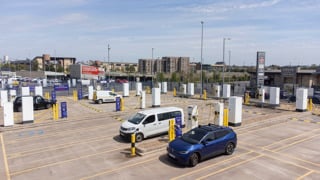 Pictured: Chris Connors and Paul Hollick
Pictured: Chris Connors and Paul Hollick
Electrification is the biggest issue facing fleets in 2021, according to a recent Fleet News survey.
Understanding a new form of vehicle technology is the biggest concern for some fleet decision-makers, while many worry about the investment cost and complexities of introducing a workplace charging infrastructure.
Some are facing pressure from senior management to implement an EV strategy at breakneck speed; others are struggling to get their voice heard, despite the UK Government announcing a ban of petrol/diesel-only new car sales from 2030 – a little over two replacement cycles away for many companies.
The introduction of viable electric vehicle and charging strategies was a hot topic at the first Fleet News at Ten webinar in January and resulted in a host of questions.
Not all could be answered at the time, but Fleet News put those questions to two of the panellists - Paul Hollick, chair at Association of Fleet Professionals, and Chris Connors, head of facilities and fleet at Countryside Properties. Here are their replies.
Fleet decision-makers can now sign up to the next Fleet News at Ten webinar on February 26, 10am, to hear the expert panel debate another agenda of important fleet topics. See Fleet News at Ten webinar Hollick and Connors took part in below.
What advice can the panel give to those fleet managers trying to introduce EVs across the business but are hitting brick walls with the board who believe this will all go away?
It’s about presenting information. Generally, most senior management will be able to think strategically with an eye for the future. Providing them access to information from several sources such as Government and manufacturers should provide them with an overview and then it’s showing how it can be applied for your fleet. There is a lot of myths with electric vehicles so that was another one of my focus areas when I presented the business case for their inclusion which I only did last year because I needed to be confident that they would suit our business.
Also, run a business case/return on investment. Use whole life costs and you should get to a point where there are savings for both your company and the employee.
Who should be liable for the cost for the charging point to be installed at an employee’s home if you have a company car?
I think it’s risky paying for charge points in home addresses. For a start you don’t know the cost and remember not every install will be simple. You may find yourself funding electrical upgrades etc. if you offer this. Perhaps look at alternatives. We have chosen to discount fully electric and PHEV cars which should encourage their take up and it also shows our commitment to environmental initiatives. There are also significant BIK savings so the Employee already. For our allowance drivers we offer a one-off payment.
AFP advice is to get the employee to pay if they have a high proportion of personal travel. That said, it can be added to a lease rate and if you want to drive the agenda forward quickly, create a solution for an employee to use and subsidise it.
Rather than providing home chargers could there be a model to make on the road charging more accessible, like fuel cards or a single app?
The government announced that new chargers on the electric highway should be contactless and frictionless (i.e. you don’t need to sign up to everyone’s individual network). That said, it doesn’t seem that all companies are doing this yet. There are already fuel cards (with limited network) and corporate credit card solutions (with 99% of the network- everyone that takes Mastercard/ VISA) already in the market.
Do you think EV charging infrastructure in UK is meeting the demand?
It’s getting there, we still need to provide accessible charging in more key locations. The Tesla supercharge network needs to be matched for non-Tesla vehicles. In my opinion pricing also needs to be reviewed as charging on the move can be very expensive. However, I do not see charging to be a barrier anymore for take up.
Not yet, but it will come. It needs more investment and existing infrastructure needs to work too (there are a lot of chargers not working).
Are those companies who have shifted to EVs offering staff members the option to charge at the workplace?
That’s the plan, we hope to have a charge point at all fixed workplaces and we are part way there. Its key driver as it takes the pressure off home charging and shows our intent to promote EVs.
Yes. This is also a non-taxable benefit for the employees with company cars. That said, it cannot be the primary place to charge their vehicle.
How easy is it for organisations that are leasing a building / office to implement EV charging points? Feedback I have seen is that it can take a long time to hear back from the landlord.
We have also found it a challenge to get charge points installed. Our experience is that some landlords are definitely better than others, but the challenges are not all down to them. When buildings and offices were designed (unless in the last 3 years) there was no consideration of vehicle charging. Therefore, we have found that there can be issues with power availability. Then it is accessing the power, where is the distribution board – some of offices where we only occupy part of the building it’s been difficult to access our DB. Then its where do you locate the charge points, again not all car parking spaces are easy to access and even the ones that are they have typical been reserved for visitors or disabled. This may mean disruptive infrastructure works are needed to install the charge points. That said, if you partner with the right charge point company, they can identify what is needed and work with you and the landlord to deliver this.
It requires a lot of liaison with landlords for sure but it is also a benefit to them in the long-run, so most will be happy as long as the charge points seem to be in the right location and don’t block access/ spaces. Landlords and building agents are very slow but I’ve not known of any landlords saying ‘no’ to the investment unless you are asking them to pay or reducing the size of the carpark.
For van fleets charged at depot there are solutions to help with energy supply, but eventually the only solution is to upgrade the power supply - this can be very costly for businesses. Any information about how firms can mitigate these upgrade costs?
At present, sadly not. It does seem to be very expensive to set up commercial, depot-based operations.

Given that all new vehicles have to be EV/PHEV from 2030, how long do you think the government grant will be offered?
I would expect this to continue for the next couple of years at least. Battery tech should be getting cheaper, so this will end when the cash price of these vehicles is on a par with the equivalent ICE cars.
What challenges do you see when OEMs will not be able to fulfil ICE orders - as they are focusing all investment of money and time on alternative fuels (i.e. a total inversion of today's EV supply position)?
I’ve been told, if the UK has the demand, the OEMs can fulfil it. That said, I am a little sceptical that with the UK outside of the EU, that we might not get the vehicles we want do to EU penalties for sales inside of the EEA (at present one EV can offset two diesel vehicles in terms of OEM penalty charges). Fortunately, the EU drive into EVs seems to be quickly than most EU member states, so we should get decent availability for the next 12 months at lease.
We have seen a big shift to EV in our fleet already. However, car usage is dropping, and I am struggling to see it recovering post Covid 19. Is the model of leasing or owning vehicles past it sell by date? Should we be focusing more on pay as you go and subscription models?
I don’t think we should focus on any one method in isolation. All have their merits and potential challenges. I think it’s about assessing the need and then tailoring solution to meet that need. This will naturally lead to different ways of funding and providing vehicles with flexibility solutions becoming more popular.
Yes, but it will also depend on your employee’s social needs. For sure, a few families will reduce the number of cars in their driveway but also, for a while at least, a lot of people will be avoiding public transport/ shared mobility.
The biggest reduction in emissions is to remove the requirement to travel in the first place. What initiatives would be good for fleets to help reduce the need to drive in the first place? Drones/remote videos etc.
I would look at the cost to our travel in terms of environment impact, financial and time lost. Challenging the need to travel in first place is a good start. Is it essential? If it is not, then have a culture where you only travel when you need to. Many a time I have commuted three hours each way or longer for a one-hour meeting. The business paid the cost of my travel, the environment was impacted by the journey and I lost a working day. Video conferencing will work fine for a lot (not all) meetings and make best use of the persons time and save the business money.
Also, make sure you are setting up policies that get drivers to travel more (i.e. only get a car if they travel more than 10,000 miles per annum for example.
With the ‘new commuting way’ post Covid, would you see car sharing model strengthening?
I can’t see this happening. I expect more people to permanently change their place of work to the home (then there is no commute – it is a business trip to the office) and also employees to avoid public transport and shared mobility – while they use individual mobility, either a company car or (dare I say it), their grey fleet vehicle. Covid will sadly slow down shared mobility for a while, at least a year, until the pandemic passes and becomes a distant memory.
Fleet News at Ten webinar recording





















Login to comment
Comments
No comments have been made yet.